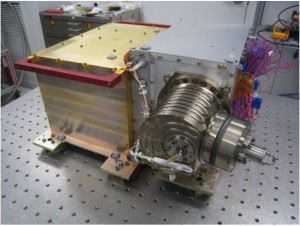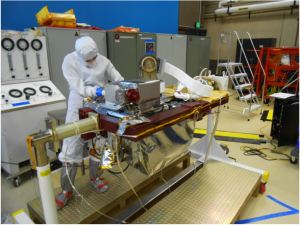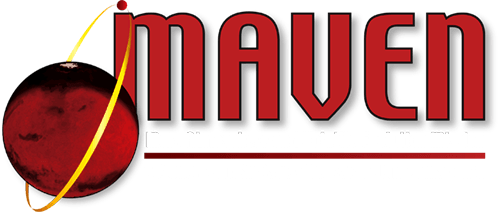
The Neutral Gas and Ion Mass Spectrometer (NGIMS) measures the composition and isotopes of thermal neutrals and ions.
Goals:
- Determine structure and variation of neutral atmosphere and ionosphere with altitude over the globe from the homopause to above the exobase where the neutral gas can escape
- Provide a basis for the study of thermospheric energetics, transport, circulation and formation of the ionosphere
- Reveal the effects of lower atmospheric effects on the composition of the upper atmosphere and escape
Observations:
- Basic structure of the upper atmosphere (major species He, N, O, CO, N2, NO, O2, Ar, and CO2) and ionosphere from the homopause to above the exobase
- Stable isotope ratios, and variations

Technical details and heritage:
- Quadrupole Mass Spectrometer with open and closed sources
- Open source: neutrals and ions
- Closed source: non-reactive neutrals
- Mass Range: 2 – 150 Da
- Mass Resolution: 1 Da
- Modes: scan entire spectra or adapt to fixed masses
- Sensitivity: 10-2 (counts/s)/(particles/cm-3)
- Heritage from Galileo GPMS, Pioneer Venus ONMS, CASSINI INMS, Contour NGIMS
Instrument publications: (sorted by most recent at top)
- Thermal Structure of the Martian Upper Atmosphere from MAVEN NGIMS
(Journal of Geophysical Research—Planets article—published online September 2018)—Download PDF (4 MB) - Thermospheric expansion associated with dust increase in the lower atmosphere on Mars observed by MAVEN/NGIMS
(Geophysical Research Letters research letter—published online March 2018)—Download PDF (2 MB) - Global distribution and parameter dependences of gravity wave activity in the Martian upper thermosphere derived from MAVEN/NGIMS observations
(Journal of Geophysical Research—Space Physics article—published online January 2017)—Download PDF (8 MB) - He Bulge Revealed: He and CO2 diurnal and seasonal variations in the Upper Atmosphere of Mars as detected by MAVEN NGIMS
(Journal of Geophysical Research—Space Physics article—published online January 2017)—Download PDF (849 KB) - Longitudinal structures in Mars’ upper atmosphere as observed by MAVEN/NGIMS
(Journal of Geophysical Research—Space Physics article—published online January 2017)—Download PDF (942 KB) - The structure and variability of Mars dayside thermosphere from MAVEN NGIMS and IUVS measurements: Seasonal and solar activity trends in scale heights and temperatures
(Journal of Geophysical Research—Space Physics article—published online December 2016)—Download PDF (3 MB) - MAVEN NGIMS Observations of Atmospheric Gravity Waves in the Martian thermosphere
(Journal of Geophysical Research—Space Physics article—published online November 2016)—Download PDF (2 MB) - Structure and Composition of the Neutral Upper Atmosphere of Mars from the MAVEN NGIMS Investigation
(Geophysical Research Letters article—published online November 2015)—Download PDF (2 MB) - Comparison of model predictions for the composition of the ionosphere of Mars to MAVEN NGIMS data
(Geophysical Research Letters article—published online November 2015)—Download PDF (821 KB) - High-altitude gravity waves in the Martian thermosphere observed by MAVEN/NGIMS and modeled by a gravity wave scheme
(Geophysical Research Letters article—published online November 2015)—Download PDF (1 MB) - Metallic ions in the upper atmosphere of Mars from the passage of comet C/2013 A1 (Siding Spring)
(Geophysical Research Letters article—published online June 2015)—Download PDF (641 KB) - The Neutral Gas and Ion Mass Spectrometer on the Mars Atmosphere and Volatile Evolution Mission
(Space Science Reviews article—published online September 2014)—Download PDF (4 MB)

Paul Mahaffy (GSFC) is the instrument lead for the NGIMS. For more about Mahaffy, visit: http://1.usa.gov/prmbio.
[VIDEO] MAVEN NGIMS: Searching for Mars’ Missing Atmosphere
MAVEN Science Community Workshop Presentation
(Dec. 2, 2012)

(5.4 MB PDF)

